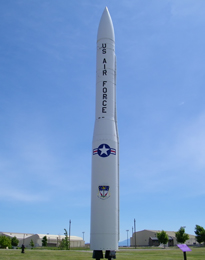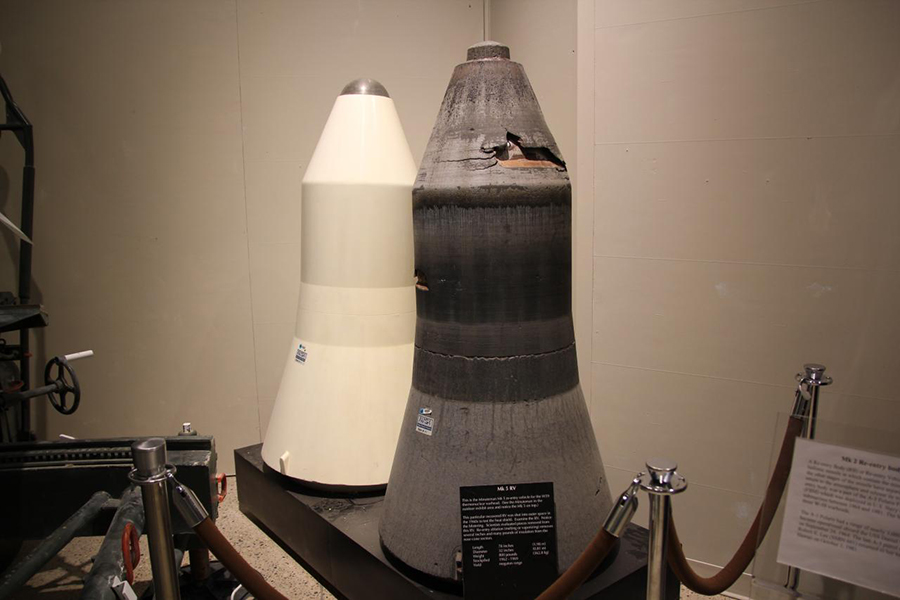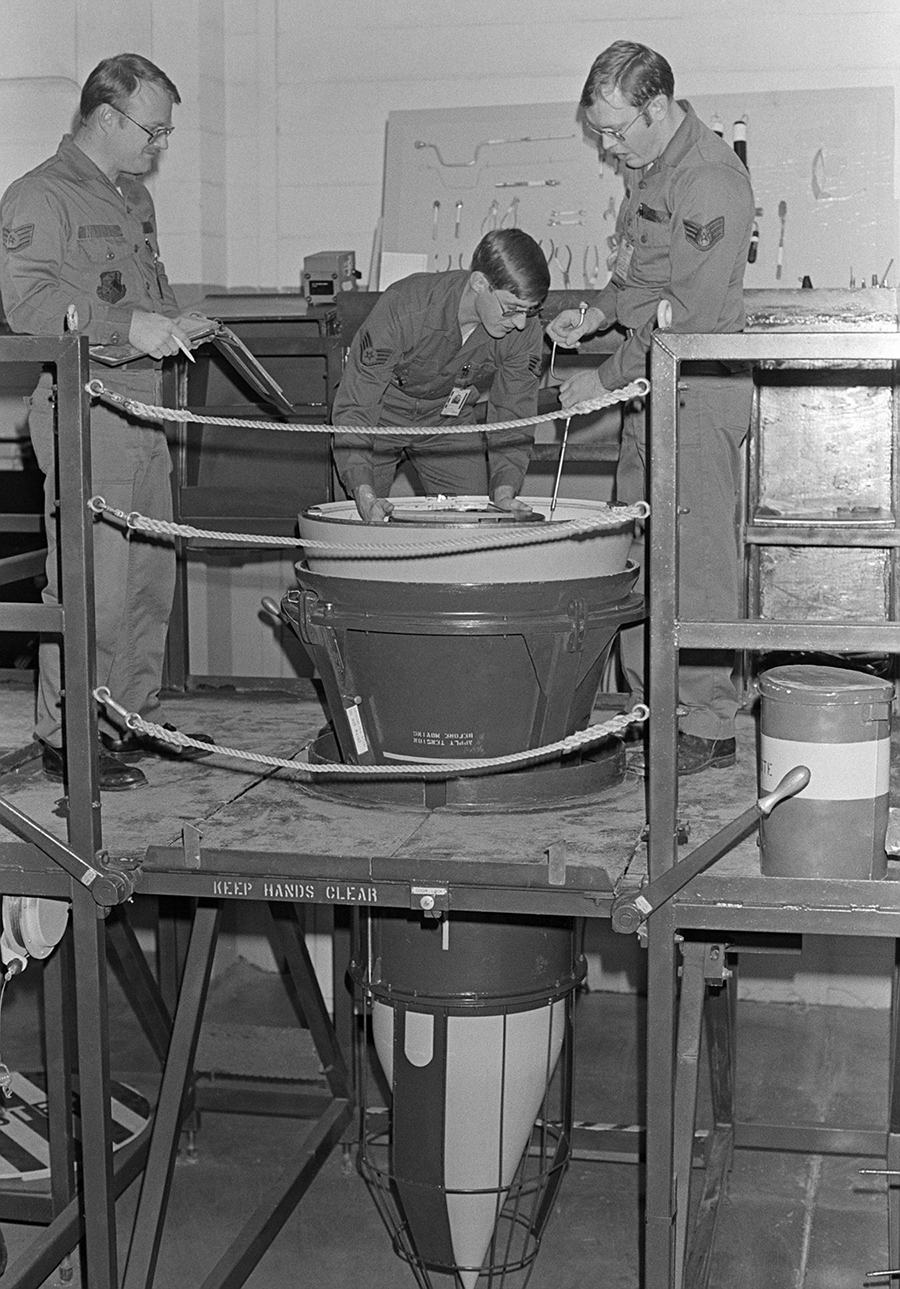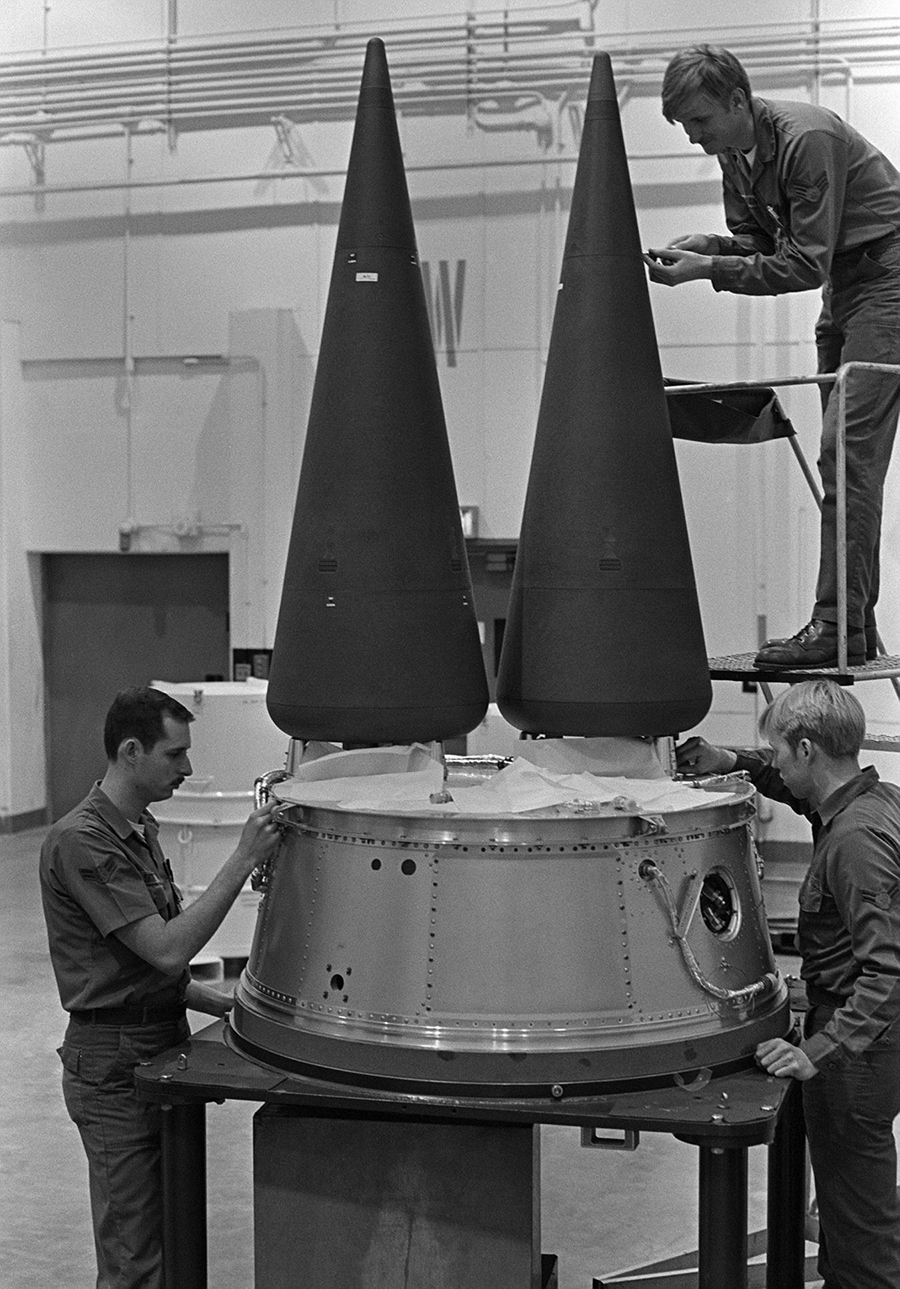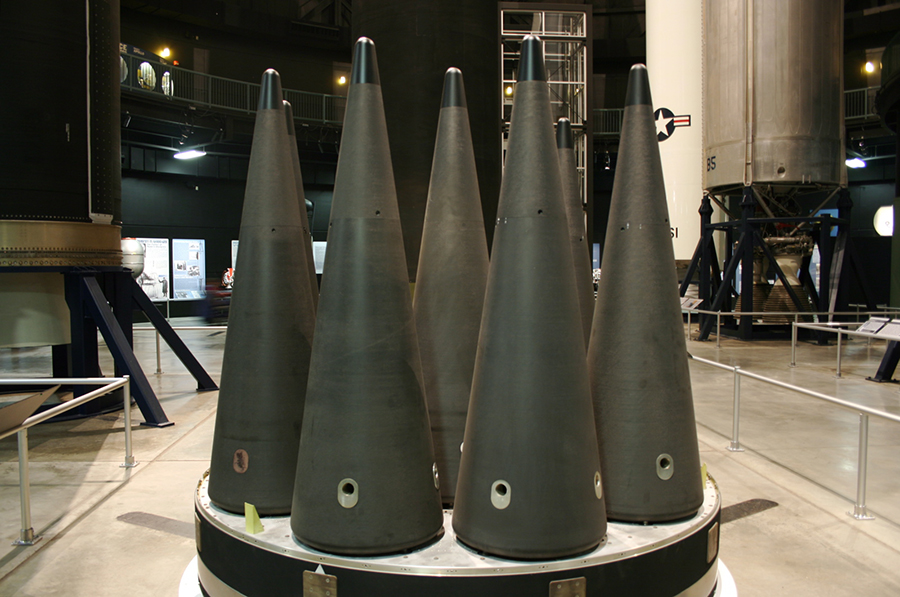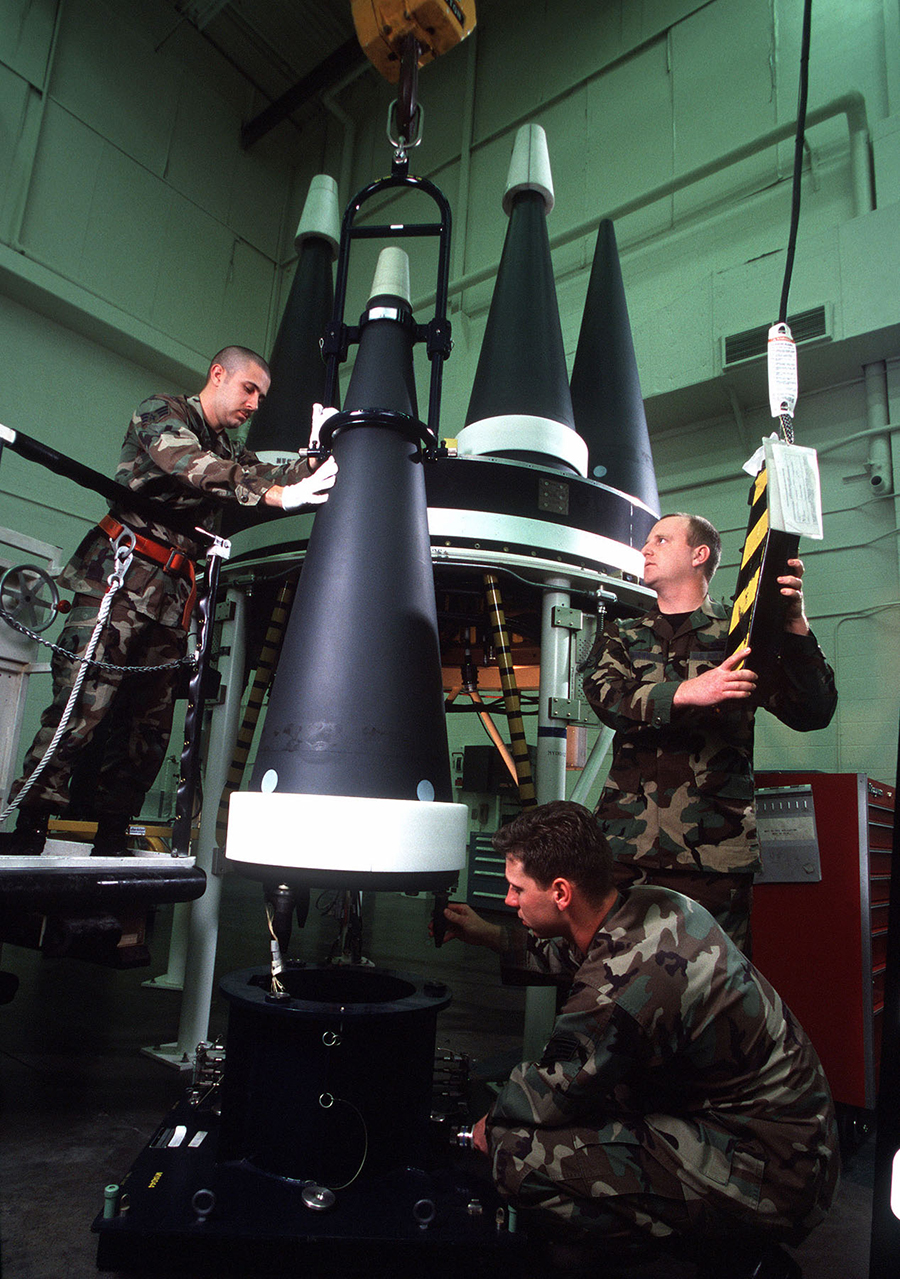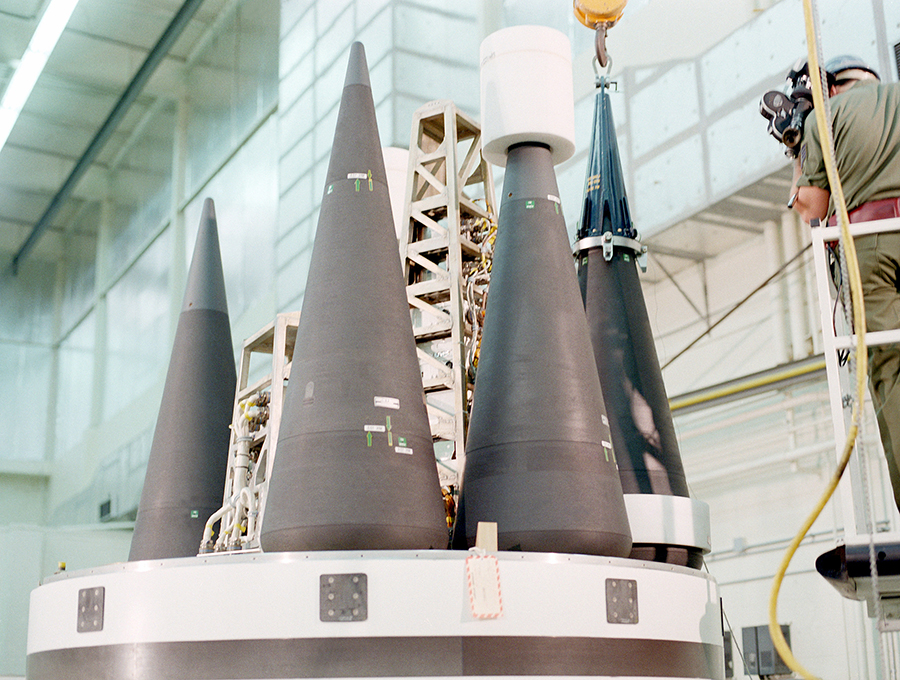Minuteman Missile Nuclear Warheads
W59 Warhead
The image above is of a Minuteman I Mk-5, W59 warhead. This warhead, also referred to as the Reentry Vehicle (RV), was used with the Minuteman IA missile. The Minuteman IA was only deployed at Malmstrom Air Force Base in Great Falls, Montana. A total of 150 W59 Mk-5 warheads were deployed on the Minuteman IA missiles assigned to Malmstrom AFB.
In terms of identification, the W59 refers to the nuclear warhead manufactured, and the term Mk-5 refers to the reentry vehicle used with that specific warhead. Combined, the warhead and reentry vehicle had a width of 16.3 inches, height of 47.8 inches and weighed 550 pounds. The W59 had a yield of 1 megaton, MT. There were a total of 175 W59 Mk-5 RVs manufactured and had an operational period from 1962 to 1969. The W59 warhead was designed and developed by Los Alamos National Laboratory, LANL.
W56 Warhead
In 1963 production for the W56 warhead began. This warhead was manufactured by Lawrence Livermore National Laboratory and were built in a series of models consisting of 4 variants. Each model had a yield of 1.2 MT. They all were of basically the same size, 17.4 inches in diameter and 47.3 inches long. Models 1 through 3 each weighed 600 pounds. Model 4 weighed 680 pounds.
The W56 warhead was used with both the Minuteman I missile and Minuteman II. The earlier models of the warhead, Models 1 through 3, were produced in 1963, and were phased out in September 1966. A total of 545 Model 1 through Model 3 warheads were produced. 455 Model 4 warheads were in production through 1969 and remained in service until 1993.
The W56 warhead was deployed with 650 Minuteman IB missiles and 450 Minuteman II missiles. Based on information available to the public, the W56 possessed one of the highest efficiencies in a nuclear warhead ever manufactured. Based on the ratio of its yield, 1.2 MT, in relation to the weight of the warhead, this warhead possessed a yield 4.9 Kilotons per 1 Kilogram of its weight.
W62 Warhead
The engineers at Lawrence Livermore National Laboratory began the design process of the W62 Mk-12 warhead/RV in June 1964. Production engineering of the W62 began in March 1967, with the actual production of the warhead beginning in March 1970. The W62 Mk-12 warhead was initially deployed on the first Minuteman III squadron to become operational, which occurred on December 29, 1970. The 741 Strategic Missile Squadron, SMS, at Minot AFB in North Dakota, were the first to emplace and deploy the Minuteman III missile.
The deployment of the Minuteman III missile realized the first ICBM that had the capacity to carry three Multiple Independently Targeted Reentry Vehicles, MIRV. In the image above one can see the payload bus for a Minuteman III missile. Two W62 warheads are already emplaced onto the payload bus. The third warhead emplacement is to follow. Prior to the Minuteman III missile, both the Minuteman I and Minuteman II missiles only had the capacity to carry 1 warhead per missile.
Advancements in technology allowed the Air Force to design the payload bus to maneuver itself into the correct location for the optimum trajectory for each of the 3 Mk-12 warheads. Smalls explosives on the bolts holding down each individual warhead allowed the individual warhead to be released from the bus, allowing the computer system of the payload bus to then navigate to the next location to release the second, and finally the third W62 warheads.
For further discussion on the function and technology of the MIRV, follow the link below.
Lawrence Livermore National Laboratory started manufacturing the W62 warhead in March 1970 and continued production until June 1976. The W62 Mk-12 warhead/RV had a width of 21 inches, and a height of 72 inches. This warhead had a yield of 170 KT, Kilotons. Weight was approximately 700 to 800 pounds. One source states 1800 of the W62 warheads were produced, a second source states a total of 1725 W62s were produced.
The accuracy of how close these warheads could get to their intended targets was a constant focus for the Air Force. The W62 had a Circular Error Probability (CEP) of 900 feet. Through the years the W78 Mk-12A warhead/RVs replaced the W62 Mk-12 warheads. Sources state that by 2009 all W62 warheads were pulled out of service.
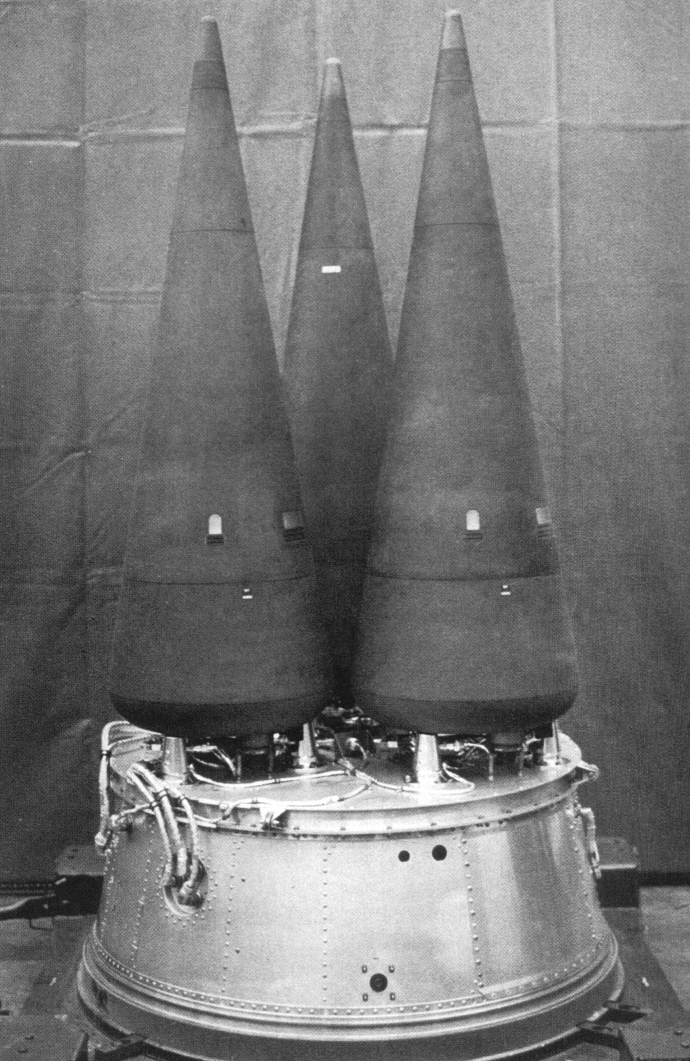
Minuteman III Mk-12 MIRV Warheads
W78 Warhead
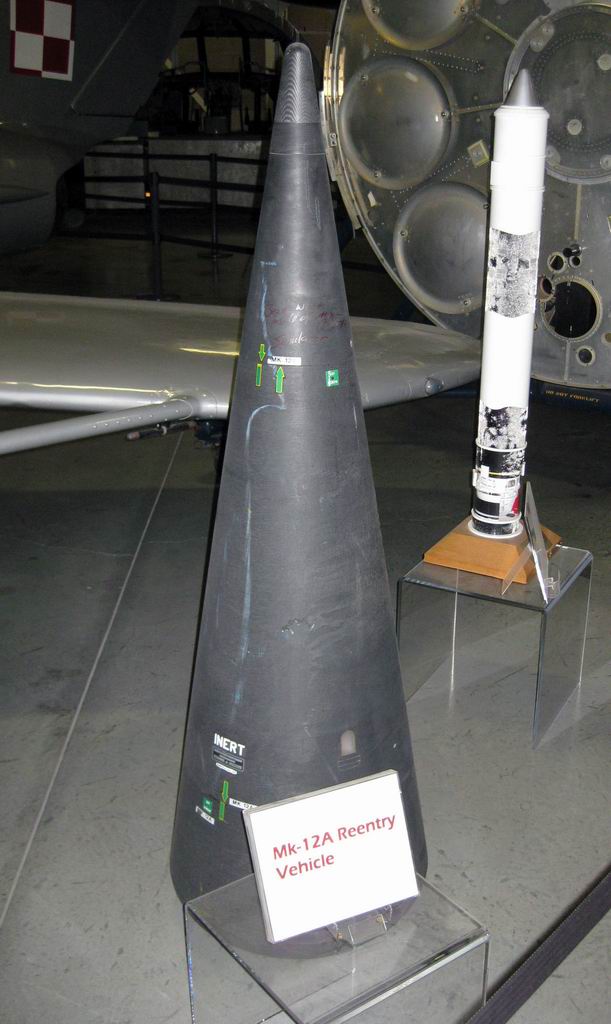
Minuteman III W78 Mk12A Warhead/RV
The W78 warhead was designed and manufactured by the Los Alamos National Laboratory, LANL. It is based on its W50 warhead design, with a diameter of 21.3 inches, height of 67.7 inches, and its weight is approximately 700 to 800 pounds. The W78 has a yield of 335 kilotons, KT. Engineering for the W78 started in November 1975, followed by the first production warheads becoming available in August 1979. LANL produced this warhead until October 1982.
One source states that a total of 1083 W78s were produced. A second source states 1000. The CEP, circular error probability, for the W78 improved compared to the W62 warhead. The W78 has a CEP of 720 feet. In the early stages of designing the W78, the Air Force was initially thinking that this warhead would be used on the MX missile, more commonly known as the Peacekeeper Missile. Once the Peacekeeper was built, the W87 warhead was used for the MX missile, (Missile eXperimental) also known as the LGM-118A.
W87 Warhead
The W87 warhead is the most current warhead deployed within the Air Force's ICBM weapon system. The W87 was designed and developed by Lawrence Livermore National Laboratory, LLNL. The design process of the W87 began in February 1982. In April 1986 the first warheads were produced, and by July 1986 full production capacity of the W87 was achieved. Lawrence Livermore National Laboratory continued production of this warhead until December 1988.
By December 22, 1986 10 MX (Missile eXperimental) missiles achieved operational capacity, attached to F.E. Warren AFB in Wyoming. F.E. Warren AFB set aside 50 Minuteman III silos, configured specifically for the MX Peacekeeper missile. F.E. Warren achieved full deployment status of 50 Peacekeeper missiles by December 1988. Sources state that the Peacekeeper missile had the capacity to carry 11 W87 Mk-21 warheads/RVs. Due to the START treaty agreements, the Peacekeeper was only configured for 10 W87 warheads.
An interesting feature of the Peacekeeper missile, is that the payload bus that carried the W87 warheads had room to carry 12 W87 Mk-21 RVs. This source is provided by the Nuclear Weapons Databook, Volume I, page 121.
When the W87 Mk-21 warhead/RV is assembled, it has a width of 21.8 inches and a height of 68.9 inches. Sources state that the W87 Mk-21 warhead/RV is heavier than the W78 warhead. Approximate weight of the W87 and RV was 800 pounds. The CEP of the W87 is 400 feet. The W87 has a yield of 300 kilotons, KT. With the W87, this warhead could have a higher yield by adding additional rings of oralloy, a highly enriched uranium, to its second stage. This can increase the warhead's yield to 475 KT.
There was preliminary work performed where the W87 was going to be used as the warhead that would have been deployed with the small ICBM, the MGM-134A, also known as the Midgetman missile. There were a few early models of the MGM-134A manufactured, but the Air Force never had this particular missile approved for production. The MGM-134A would have carried a single W87 Mod 1 warhead, carrying the higher yield warhead of 475 KT. The W87 Mod 0 with its 300 KT yield, was used with the Peacekeeper missile, and is currently deployed with the Minuteman III missiles at F.E. Warren AFB, Minot AFB, and Malmstrom AFB.
The Mk-21 reentry vehicle (RV) used with the W87 warhead was previously known as the ABRV, Advanced Ballistic Reentry Vehicle, designed by AVCO Systems Division. This RV affords the warhead greater accuracy. The AVCO reentry vehicles are of a heavier weight in design, but the Air Force was really drawn by their greater accuracy, possessing a CEP of 400 feet. Part of the strategy incorporating greater accuracy was the ability to strike nuclear hardened targets with superior accuracy, with the goal of a higher probability of eliminating the target.
One sources states that a total of 560 W87 warheads were produced. A second source states a total of 525 warheads were manufactured.
